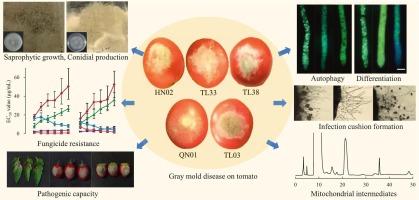杀菌剂促进温室番茄灰霉病菌分化及多药耐药
IF 4
1区 农林科学
Q2 BIOCHEMISTRY & MOLECULAR BIOLOGY
引用次数: 0
摘要
番茄灰霉病是一种坏死性真菌病原体,在收获前和收获后都会引起番茄腐烂。使用杀菌剂往往会导致不同菌株产生不同的耐药性,因此需要详细的区分概况以进行有效控制。本研究对8种杀菌剂(boscalid (Bos)、pyrimethanil (Pyr)、cyprodinil (Cyp)、iprodione (Ipr)、procymidone、tebuconazole、prochloraz和pyrisoxazole)的耐药性进行了检测,评估了其在径向生长、分生孢子产生和致病性方面的适应度损失,并通过感染缓冲(infection cushion, IC)形成、自噬和线粒体代谢等途径初步探讨了其分化机制。结果表明,菌株QN01和TL03对Bos、Pyr和Cyp均有抗性,EC50值分别为38.53、50.04、11.95 μg/mL (QN01)和23.58、26.27、8.16 μg/mL (TL03),对其他杀菌剂均保持敏感,表现为PyrHRBosMRCypR抗性表型,而其他菌株对所有杀菌剂均敏感。各菌株均能旺盛生长,但在孢子萌发和管伸长过程中,分生孢子产量、致病性和对杀菌剂的敏感性存在显著差异。此外,QN01对IC的产生具有高度的表面敏感性,具有累积的自噬,而TL03表现出明显的分生分化和较高的柠檬酸盐、草酸盐和磷酸盐水平。异丙地酮处理后,QN01的柠檬酸盐和磷酸盐水平升高,而TL03的柠檬酸盐和磷酸盐水平降低,且QN01消耗草酸盐的速度快于TL03。结果强调了杀菌剂增强的分化和菌丝生长相关的抗性,强调了二甲肟类、三唑类和吡恶唑类是控制灰霉病的有效药物。本文章由计算机程序翻译,如有差异,请以英文原文为准。

Fungicide-enhanced differentiation and multidrug resistance of Botrytis cinerea on greenhouse tomato
Botrytis cinerea, a necrotrophic fungal pathogen, causes rotting of tomato at both pre-harvest and postharvest stages. Fungicide practices often lead to differential resistance in isolates, necessitating detailed differentiation profiles for effective control. This study tested the resistance of B. cinerea isolates to eight fungicides (boscalid (Bos), pyrimethanil (Pyr), cyprodinil (Cyp), iprodione (Ipr), procymidone, tebuconazole, prochloraz, and pyrisoxazole), evaluated fitness penalties in radial growth, conidial production, and pathogenicity, and primarily explored the differentiation mechanism via infection cushion (IC) formation, autophagy, and mitochondrial metabolism. Results revealed that isolates QN01 and TL03 showed resistance to Bos, Pyr, and Cyp, with EC50 values of 38.53, 50.04, 11.95 μg/mL (QN01) and 23.58, 26.27, 8.16 μg/mL (TL03), respectively, and remained sensitive to other fungicides, exhibiting a PyrHRBosMRCypR resistance phenotype, while other isolates were sensitive to all tested fungicides. All isolates were capable of thriving growth, but significant differed in conidia production, pathogenicity, and sensitivity to fungicides in conidial germination and tube elongation. Moreover, QN01 was highly surface-sensitive for IC production, with accumulated autophagy, while TL03 showed marked conidiation differentiation and higher citrate, oxalate, and phosphate levels. Upon iprodione treatment, QN01's citrate and phosphate levels increased while TL03's decreased, accompanying with QN01 depleting oxalate faster than TL03. The results highlighted the fungicide-enhanced differentiation and the mycelial growth-linked resistance among isolates, emphasizing dicarboximides, triazoles, and pyrisoxazole as effective agents for grey mold management.
求助全文
通过发布文献求助,成功后即可免费获取论文全文。
去求助
来源期刊
CiteScore
7.00
自引率
8.50%
发文量
238
审稿时长
4.2 months
期刊介绍:
Pesticide Biochemistry and Physiology publishes original scientific articles pertaining to the mode of action of plant protection agents such as insecticides, fungicides, herbicides, and similar compounds, including nonlethal pest control agents, biosynthesis of pheromones, hormones, and plant resistance agents. Manuscripts may include a biochemical, physiological, or molecular study for an understanding of comparative toxicology or selective toxicity of both target and nontarget organisms. Particular interest will be given to studies on the molecular biology of pest control, toxicology, and pesticide resistance.
Research Areas Emphasized Include the Biochemistry and Physiology of:
• Comparative toxicity
• Mode of action
• Pathophysiology
• Plant growth regulators
• Resistance
• Other effects of pesticides on both parasites and hosts.

 求助内容:
求助内容: 应助结果提醒方式:
应助结果提醒方式:


